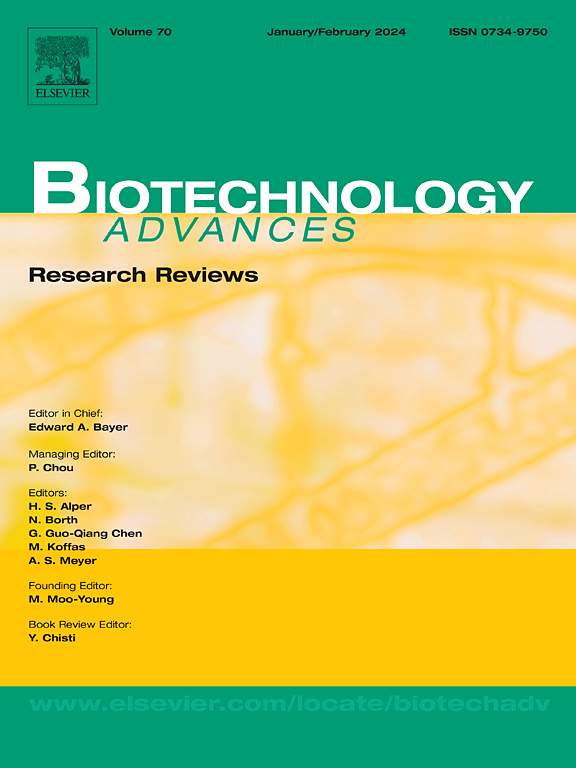建造湿地微生物燃料电池作为提高污染物处理技术的绿色能源。
IF 12.1
1区 工程技术
Q1 BIOTECHNOLOGY & APPLIED MICROBIOLOGY
引用次数: 0
摘要
由于环保技术进展缓慢和污染物不断累积,水污染这一长期挑战变得更加严峻,这凸显了对创新解决方案的需求。构筑湿地微生物燃料电池(CW-MFC)是一项引人关注的环保技术,它能够消除废水中的污染物,同时还能生产绿色能源。近年来,CW-MFC 技术因其可持续性和无废物循环工业的美好前景而备受关注。然而,由于面临各种技术和生物挑战,该技术尚未实现大规模应用。本综述研究了 CW-MFC 技术的现状,并通过对生物组件的操作和结构改进,确定了生物和非生物优化策略。我们的综述强调了几个重要发现:(1)植物通过径向氧损失、蒸腾作用和高光合作用流量等机制,在降低系统内阻方面发挥着重要作用,这有利于电活性细菌的生长并影响氧化还原电位。(2)根系孔隙率、韧皮部和气生根发育、叶绿素含量和植物生物量等植物特征是 CW-MFC 性能的关键指标,对污染物去除和能量收集都有显著影响。(3)我们扩大了选择合适植物的标准,除了传统的水生植物和 C4 植物外,还包括中生植物和 C3 耐污染物种。此外,综述还介绍了几种提高 CW-MFC 效率的技术方法:(1)优化设计;(2)使用新型材料;(3)应用外部电场、曝气、光照和温度调节。CW-MFC 几乎能完全消除各种污染物,包括有机物(84 % ± 10)、总氮(80 % ± 7)和磷(79 % ± 18)化合物、金属(86 % ± 10)、药物(87 % ± 7)、染料(90 % ± 8)以及其他复杂污染物,同时还能产生绿色能源。我们希望我们的研究结果将有助于优化 CW-MFC 的设计,并为旨在推动该技术发展和促进其未来推广的研究人员提供见解。本文章由计算机程序翻译,如有差异,请以英文原文为准。

Constructed wetland microbial fuel cell as enhancing pollutants treatment technology to produce green energy
The persistent challenge of water pollution, exacerbated by slow progress in ecofriendly technologies and accumulating pollutants, underscores the need for innovative solutions. Constructed Wetland Microbial Fuel Cell (CW-MFC) emerges as an intriguing environmental technology capable of adressing this issue by eliminating contaminants from wastewater while simultaneously producing green energy as an additional bonus. In recent years, CW-MFC technology has gained attention due to its sustainability and promising prospects for a circular waste-free industry. However, due to various technological and biological challenges, it has not yet achieved wide-scale application. This review examines the current state of CW-MFC technology and identifies both biotic and abiotic strategies for optimization through operational and structural improvements affecting biocomponents. Our review highlights several key findings: (1) Plants play an important role in reducing the system's inner resistance through mechanisms such as radial oxygen loss, evapotranspiration, and high photosynthetic flow, which facilitate electroactive bacteria and affect redox potential. (2) Plant characteristics such as root porosity, phloem and aerenchyma development, chlorophyll content, and plant biomass are key indicators of CW-MFC performance and significantly impact both pollutant removal and energy harvesting. (3) We expand the criteria for selecting suitable plants to include mesophytes and C3 pollutant-tolerant species, in addition to traditional aquatic and C4 plants. Additionally, the review presents several technical approaches that enhance CW-MFC efficiency: (1) design optimization, (2) use of novel materials, and (3) application of external electrical fields, aeration, light, and temperature adjustments. CW-MFCs are capable of nearly complete elimination of a wide range of contaminants, including organic matter (84 % ± 10), total nitrogen (80 % ± 7) and phosphorus (79 % ± 18) compounds, metals (86 % ± 10), pharmaceuticals (87 % ± 7), dyes (90 % ± 8), and other complex pollutants, while generating green energy. We hope our findings will be useful in optimizing CW-MFC design and providing insights for researchers aiming to advance the technology and facilitate its future scaling.
求助全文
通过发布文献求助,成功后即可免费获取论文全文。
去求助
来源期刊

Biotechnology advances
工程技术-生物工程与应用微生物
CiteScore
25.50
自引率
2.50%
发文量
167
审稿时长
37 days
期刊介绍:
Biotechnology Advances is a comprehensive review journal that covers all aspects of the multidisciplinary field of biotechnology. The journal focuses on biotechnology principles and their applications in various industries, agriculture, medicine, environmental concerns, and regulatory issues. It publishes authoritative articles that highlight current developments and future trends in the field of biotechnology. The journal invites submissions of manuscripts that are relevant and appropriate. It targets a wide audience, including scientists, engineers, students, instructors, researchers, practitioners, managers, governments, and other stakeholders in the field. Additionally, special issues are published based on selected presentations from recent relevant conferences in collaboration with the organizations hosting those conferences.
 求助内容:
求助内容: 应助结果提醒方式:
应助结果提醒方式:


